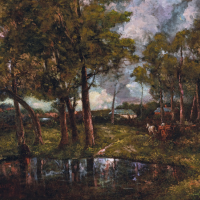46. WALTER WITHERS

Evening c1890 by Australian Impressionist Walter Withers is a distinguished painting with interesting provenance and a strong exhibition history. It was originally acquired by the family of James Oddie, founder of the Art Gallery of Ballarat. It was subsequently sought by two distinguished South Australian collectors and has been offered for sale only twice in the past 45 years.
Walter Withers painted Evening c1890 at the height of the Australian Impressionism. Along with Arthur Streeton (1867-1943), Tom Roberts (1856-1931) and Frederick McCubbin (1855-1917), Withers challenged the prevailing late nineteenth century Australian art establishment. Together, they painted directly from nature, embracing the painted sketch as a legitimate work of art, and valuing the radical, broken colour brushstrokes of revered French Impressionists such as Claude Monet (1840-1926).
Walter Withers contribution to Australian Impressionism was significant and, like his fellow painters, his focus was upon poetic moments and the changing times of the day notably at dawn, midday, and dusk. Evening is a painting in which we experience a transition from day to night. The last rays of sunshine emanate from low lying purplish clouds passing through a clearing to illuminate the pond in full flush. The ensuing glow and the backlit silhouettes of trees enliven the work, giving it a convincing focus, reinforced by a crescent moon that appears in the top right of the painting.
Critics of the day were quick to seize upon Withers unusual and shadowy poeticism. In early May 1889, Melbournes Table Talk reported that Withers had recently moved to Melbourne from Charterisville. He shared the home in Heidelberg of fellow artist David Davies (1864-1939) with Roberts and Streeton and was focusing on spring and autumn paintings for a forthcoming exhibition.1
A painting done soon after, After the Heat of the Day 1891 has also recently become known. Exhibited in Walter Withers Studio Exhibition held at Mutual Provident Buildings, 463 Collins Street, Melbourne in May 1891, the work was the subject of lengthy critical expositions. Noting that the exhibition had entertained a large number of visitors, the critic singled out After the Heat of the Day as the principal work claiming it for posterity as representative of:
that Australian idyll, so soft is the effect, and so harmonious the colouring. The scene is one that can be found anywhere along the Yarra Bank a few miles out of Melbourne, but Mr Withers has painted it at its best, when it has been glorified by the last gleams of sunshine, and when faint purple clouds have broken the blueness of the summer sky[It is] the work of a man who studied Australian [illeg.] with no hasty methods, but with the slow and persevering observation of one who notes a change of effect in every day of the year.2
Despite his early success, the 1890 Depression almost derailed Withers attempts to make a living from his art. With the help of Fred McCubbin, Withers gained employment and in 1893 taught art at Creswick, outside Ballarat. According to art historian Andrew Mackenzie, Withers gave day classes en plein air and evening drawing classes at the School of Mines; among his students were Percy and Norman Lindsay.3 Although undocumented, it is probable that Evening c1890 was acquired by Ballarats Oddie family in that year, prior to Withers return to Melbourne.
FOOTNOTES
1. Table Talk, 3 May 1889, p.4
2.Table Talk, 22 May 1891, p.4
3. Mackenzie, A., 'Withers, Walter Herbert (18541914)', Australian Dictionary of Biography, National Centre of Biography, Australian National University, published first in hardcopy 1990, accessed 15 May 2022: https://adb.anu.edu.au/biography/withers-walter-herbert-9165/text16183,
Rodney James
Rodney James is an independent art consultant who specialises in valuations, collection management, exhibitions, research and writing, and strategic planning for art galleries and museums.